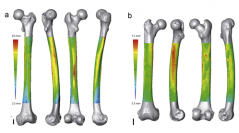

 Comptes Rendus Palevol
12 (4) - Pages 223-231
Comptes Rendus Palevol
12 (4) - Pages 223-231Within the limits imposed by a number of developmental and rheological factors, endostructural arrangement of the appendicular skeleton is consistent with the functional patterns of stress, where cortical bone topographic thickness variation in long bones primarily reflects the nature, direction, intensity, and frequency of the locomotion-related biomechanical loads. By applying techniques of cross-sectional geometric analysis and 3D morphometric mapping to a (micro)tomographic record consisting of 12 modern human and 10 chimpanzee adult femora, we have shown two distinct patterns (functional “signatures”) of cortical bone arrangement along the shaft (20–80% portion of the biomechanical length) specifically associated to the bipedal (Homo) and the quadrupedal modes (Pan). In particular, the inner structure of the human femoral diaphysis is adapted to antero-posterior loadings and presents a greater rigidity against posterior bending, while that of Pan is characterized by the presence of strong medial and lateral bony reinforcements positioned above its femoral midshaft.
Locomotion, Femoral shaft, Inner structure, Homo, Pan